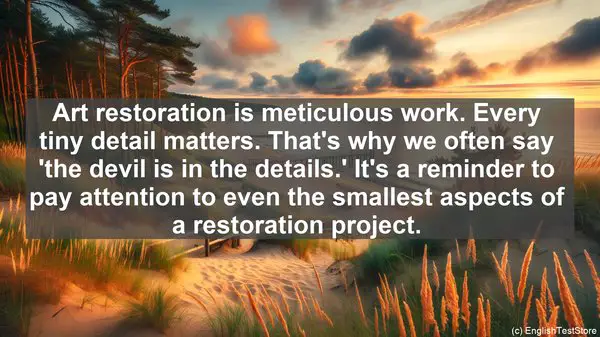Introduction: The Art of Restoration
Welcome to today’s lesson on English idioms for art restorers. Art restoration is a fascinating field that requires both technical expertise and a deep understanding of the art world. But it’s not just about the techniques; communication plays a crucial role too. That’s where idioms come in. They add color and depth to our conversations. So, let’s dive into the world of idioms for art restorers!
1. ‘A Labor of Love’
When we say restoring a piece of art is ‘a labor of love,’ we mean it’s a task that requires immense dedication and passion. It’s not just a job; it’s a heartfelt endeavor. This idiom perfectly captures the emotional connection art restorers have with their work.

2. ‘A Needle in a Haystack’
In art restoration, sometimes finding the right solution or technique can be like searching for ‘a needle in a haystack.’ It’s a challenging and time-consuming process. This idiom is a reminder of the patience and persistence required in the field.
3. ‘A Stroke of Genius’
When an art restorer comes up with a brilliant solution or idea, we can say it’s ‘a stroke of genius.’ It’s that moment of inspiration that can make all the difference in restoring a piece to its former glory.
4. ‘The Devil is in the Details’
Art restoration is meticulous work. Every tiny detail matters. That’s why we often say ‘the devil is in the details.’ It’s a reminder to pay attention to even the smallest aspects of a restoration project.

5. ‘A Picture is Worth a Thousand Words’
In the art world, a visual representation can convey more than words ever could. ‘A picture is worth a thousand words’ is a timeless idiom that emphasizes the power of visual communication, which is essential for art restorers.
6. ‘To Paint with Broad Strokes’
Sometimes, in art restoration, it’s necessary to take a broader approach rather than getting caught up in the details. ‘To paint with broad strokes’ means to tackle a task in a general or overarching way. It’s about seeing the bigger picture.
7. ‘To Leave No Stone Unturned’
When restoring art, it’s crucial to be thorough. ‘To leave no stone unturned’ means to examine every aspect and explore all possibilities. It’s a reminder of the comprehensive nature of the restoration process.
8. ‘To Make a Clean Sweep’
After completing a restoration project, if everything looks perfect, we can say the restorer ‘made a clean sweep.’ It means they did an excellent job, leaving no trace of the previous damage.
9. ‘To Stand the Test of Time’
One of the goals of art restoration is to ensure that the piece can ‘stand the test of time.’ It means the restoration work is of such high quality that it will endure for years, preserving the artwork’s beauty and integrity.
10. ‘To Bring Something Back to Life’
When an art restorer successfully restores a piece, it’s like ‘bringing it back to life.’ It’s a transformative process that revives the artwork’s original essence, often making it even more stunning than before.
Conclusion: The Language of Art Restoration
English idioms not only enrich our language but also provide insights into the world of art restoration. They capture the nuances and challenges of the field. So, as you continue your journey in art restoration, remember to explore and master the idioms. They’ll not only enhance your communication but also deepen your understanding of this captivating domain. Thank you for watching, and until next time, happy restoring!
